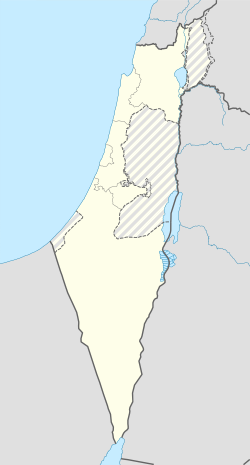Horvat 'Anim
Khirbet Ghuwein al-Tahta
خربة غويين التحتا Horvat ʽAnim (חורבת ענים) | |
|---|---|
Ruin / archaeological hamlet | |
| Coordinates: 31°21′13″N 35°03′49″E / 31.3536°N 35.0635°E | |
| Country | Israel |
| District | Southern District |
| Population | |
• Total | Uninhabited (ruins) |
| Time zone | UTC+2 (IST) |
| • Summer (DST) | UTC+3 (IDT) |
| Also known as | Khirbet Ghuwein et-Taḥta; Lower Ḥorvat ʽAnim |
| Anim Synagogue (at Lower ʽAnim) | |
 | |
 | |
| Type | Ancient synagogue |
| History | |
| Founded | 4th–7th centuries CE |
| Abandoned | 7th–8th centuries CE |
| Periods | Roman–Byzantine |
| Site notes | |
| Excavation dates | 1988–1989 |
| Archaeologists | Z. Ilan; Dan Urman |
| Public access | Yes |
Horvat ʽAnim (Hebrew: חורבת ענים) or Khirbet Ghuwein al-Tahta (Arabic: خربة غويين التحتا, “Lower Ghuwein”) is a ruined hamlet and archaeological locality in the southern fringes of the Hebron Hills, within Israel’s Southern District, inside the Yatir Forest. The site is identified with the lower of the two historical settlements known as Anim/Anaia from Biblical times and Late Antiquity and preserves the remains of the Anim Synagogue.[1][2][3][4][5]
Geography
[edit]Lower ʽAnim lies on a rocky hill within the Yattir uplands at the northern edge of the Negev. The ruins area is studded with caves, water cisterns, stone fences, and rock-cut installations typical of dry-farming landscapes in the southern Judean hills.[6]
History
[edit]Scholars identify Lower ʽAnim with the Jewish settlement mentioned by Eusebius as Anaia, pairing it with a Christian counterpart at Upper ʽAnim (Arabic: Khirbet Ghuwein al-Fauqa) nearby.[7] The site preserves caves, cisterns and architectural remains that 19th-century explorers described in detail.[8]
Nineteenth-century and early twentieth-century surveys record the location as an Arab hamlet/ruin known as Khirbet Ghuwein et-Tahta (Lower Ghuwein). In 1838, Edward Robinson and noted al-Ghuwein as a ruin located southwest of el-Khulil.[9] In the 1870s, Survey of Western Palestine recorded Khurbet el Ghuwein et Taḥta as consisting of “traces of ruins and caves.”[10]
The surrounding area formed part of the southern Hebron/Judean hills rural economy based on field crops, cisterns and seasonal cave dwellings.[11][12]
Following 1949, the site has lain within Israel and today is encompassed by the Yatir Forest recreational area; the ruins are accessible by marked trails.[13]
Anim Synagogue
[edit]Archaeological remains of a rectangular, basilical synagogue (approx. 14.5 × 8.5 m) date its main phase to the 4th–7th centuries CE, with later conversion to a mosque in the early Islamic period. Excavations by Z. Ilan and Dan Urman (1988–89) reported standing hewn-stone walls to c. 3.5 m, an eastern entrance with preserved lintels, traces of a mosaic pavement beneath a later stone floor, and inscription fragments.[14][15] The synagogue at Lower ʽAnim is paired historically with a Byzantine-era church on the hill east of Upper ʽAnim, reflecting the Christianisation patterns of the South Hebron Hills in Late Antiquity.[16][17]
Palestinian hamlet (Khirbet Ghuwein al-Tahta)
[edit]Historical surveys list the locus as an Arab hamlet/ruin (khirbet) named Khirbet Ghuwein et-Tahta (Lower Ghuwein). Remains include rock-hewn cisterns, terraces and caves indicative of seasonal agro-pastoral use; the site today is uninhabited within Yatir Forest.[18][19][20]
See also
[edit]- Khirbet Ghuwein al-Fauqa – the upper (Fauqa) hamlet 2–5 km to the northeast
- Masafer Yatta – wider South Hebron Hills context
References
[edit]- ^ Urman, Dan; Flesher, Paul V.M. (1998). Ancient Synagogues: Historical Analysis and Archaeological Discovery. Leiden: Brill. pp. 135–136. ISBN 978-90-04-11254-4.
- ^ Chapmann III, R.L.; Taylor, J.E., eds. (2003). Palestine in the Fourth Century A.D.: The Onomasticon by Eusebius of Caesarea. Translated by G.S.P. Freeman-Grenville. Jerusalem: Carta. pp. 23, 110. ISBN 965-220-500-1.
- ^ Tsafrir, Yoram; Di Segni, Leah; Green, Judith (1994). Tabula Imperii Romani: Iudaea–Palaestina. Jerusalem: Israel Academy of Sciences and Humanities. p. 62. ISBN 965-208-107-8.
- ^ Chapmann III, R.L.; Taylor, J.E., eds. (2003). Palestine in the Fourth Century A.D.: The Onomasticon by Eusebius of Caesarea. Translated by G.S.P. Freeman-Grenville. Carta. pp. 23, 110. ISBN 965-220-500-1.
- ^ Sefi Ben-Yosef, ed. (n.d.). Israel Guide – Judaea (in Hebrew). Vol. 9. Jerusalem: Keter / Israel Ministry of Defence. p. 220. OCLC 745203905.
- ^ "Yatir Forest – Hurvat ʽAnim". KKL–JNF. Retrieved September 9, 2025.
- ^ Tsafrir, Yoram; Di Segni, Leah; Green, Judith (1994). Tabula Imperii Romani: Iudaea–Palaestina. p. 62.
- ^ Victor Guérin (1869), Description Géographique Historique et Archéologique de la Palestine, vol. 2, pp. 343–345.
- ^ Robinson and Smith, 1841, vol 3, Appendix 2, p. 116
- ^ Conder and Kitchener, Survey of Western Palestine, Vol. III: Judaea, p. 408.
- ^ Victor Guérin (1869), vol. 2, 343–345.
- ^ "Yatir Forest – Hurvat ʽAnim". KKL–JNF. Retrieved September 9, 2025.
- ^ "Yatir Forest – Hurvat ʽAnim". KKL–JNF. Retrieved September 9, 2025.
- ^ Urman, Dan; Flesher, Paul V.M. (1998). Ancient Synagogues: Historical Analysis and Archaeological Discovery. Brill. pp. 135–136.
- ^ Stemberger, Günter (2000). Jews and Christians in the Holy Land: Palestine in the Fourth Century. Continuum. pp. 150–151. ISBN 978-0-567-08699-0.
- ^ Bar, Doron (July 2003). "The Christianisation of Rural Palestine during Late Antiquity". Journal of Ecclesiastical History. 54 (3): 413. doi:10.1017/S0022046902007152 (inactive September 26, 2025).
{{cite journal}}: CS1 maint: DOI inactive as of September 2025 (link) - ^ Tsafrir, Yoram; Di Segni, Leah; Green, Judith (1994). Tabula Imperii Romani: Iudaea–Palaestina. p. 62.
- ^ Victor Guérin (1869), vol. 2, 343–345.
- ^ "Yatir Forest – Hurvat ʽAnim". KKL–JNF. Retrieved September 9, 2025.
- ^ "Horvat ʽAnim". BibleWalks. Retrieved September 9, 2025.
External links
[edit] Media related to Anim synagogue at Wikimedia Commons
Media related to Anim synagogue at Wikimedia Commons- Chen, D.; Milson, D. "The Design of the Ancient Synagogues in Judea: Horvat Ma'on and Horvat ʽAnim" (PDF). christusrex.org (archived). Archived from the original (PDF) on October 4, 2012.

